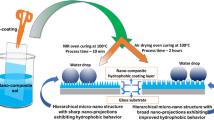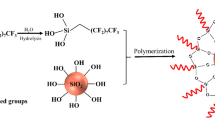Abstract
Fluorinated silica nanofillers were used to prepare hybrid sol–gel superhydrophobic coatings. A shot blasting technique was used to create microlevel roughness over which the sol–gel composition helped to impart a superhydrophobic behaviour. The sols were deposited on shot blasted stainless steel 304 substrates using the spray-coating technique followed by thermal curing and curing using near-infrared radiation for the first time, to study the effect of curing technique and curing time on the properties of the superhydrophobic coatings. The total curing time was 3 h for the thermal-cured samples vis-à-vis 45 min for the near-infrared radiation-cured samples. Coatings were characterized for surface roughness, water contact angles, abrasion resistance, scratch resistance, weathering resistance and corrosion resistance. Investigations were carried out to comparatively assess the coating properties of near-infrared radiation-cured coatings with those of the thermal-cured coatings. Optimized shot blasting conditions and filler quantity resulted in a highest water contact angle of 165° and a rolling angle of 5° with best possible mechanical properties. It could be seen that the thermal-cured samples exhibited slightly better properties than the near-infrared radiation-cured ones, though the difference is not substantial. Near-infrared radiation curing can be considered in place of thermal curing in order to save time and if the required scratch/abrasion resistance for end-use applications is not too high.









Similar content being viewed by others
References
Kantesh B, Ruben G B, Debrupa L, and Arvind A, Nanotechnology 20 (2009) 305707.
Sanjay S L, Annaso B G, Chavan S M, and Rajiv S V, J Surf Eng Mater Adv Technol 2 (2012) 76.
Jitong L, Lei Z, Nan Y, Chunlei G, and Yongmei Z, RSC Adv 7 (2017) 44234.
Xu Q F, Wang J N, and Sanderson K D, ACS Nano 4 (2010) 2201.
Kumar D, Wu X, Fu Q, Ho J W C, Kanhere P D, Li L, and Chen Z, Appl Surf Sci 344 (2015) 205.
Yuan T, Kai G, Xiufang B, Tianqi W, Suhong C, and Jiaxiang S, Surf Coat Technol 328 (2017) 444.
Zhang H, Tan J, Liu Y, Hou C, Ma Y, Gu J, Zhang B, Zhang H, and Zhang Q, Mater Des 135 (2017) 16.
Shan W, Yun C, Dan J, and Ze-Hua D, Colloids Surf A 538 (2018) 628.
Pantoja M, Abenojar J, and Martinez M A, Appl Surf Sci 397 (2017) 87.
10. Youfa Z, Dengteng G, and Shu Y, J Colloid Interface Sci. 423 (2014) 101.
Athanasios M, Eric L, and llker S B, Adv Colloid Interface Sci 229 (2016) 57.
Bake A, Merah N, Matin A, Gondal M, Qahtan T, and Abu-Dheir N, Prog Org Coat 122 (2018) 170.
Brown S, Lengaigne J, Sharifi N, Pugh M, Moreau C, Dolatabadi A, Martinu L, and Klemberg-Sapieha J E, Surf Coat Technol 401 (2020) 126249.
Longyang L, Jingfang Z, and Zhixiang Z, Prog Org Coat 147 (2020) 105863.
Knischika R, Lehmann U, Stadler U, Mamak M, and Benkhoff J, Prog Org Coat 64 (2009) 171.
Pradheebha S, Ignatius A B, Srinivasa Rao K, and Subasri R, Int J Nanobiotechnol. 4 (2018) 21.
Xiaoxiao Z, Daniel S P, Junseo C, Sunggook P, Steven A S, and Michael C M, J Colloid Interface Sci 574 (2020) 347.
Acknowledgements
Authors would like to thank Director, ARCI for constant support and encouragement throughout the course of this investigation. Authors would like to acknowledge the technical support extended by J.V.Rao for shot blasting and spray coating. They are also thankful to D. Nazeer Basha and A. Naveen Kumar for roughness and sliding angle measurements.
Author information
Authors and Affiliations
Corresponding author
Additional information
Publisher's Note
Springer Nature remains neutral with regard to jurisdictional claims in published maps and institutional affiliations.
Rights and permissions
About this article
Cite this article
Rao, K.S., Yogapriya, R., Raju, K.R.C.S. et al. Effect of Curing Technique on the Properties of Superhydrophobic Coatings. Trans Indian Inst Met 74, 1923–1932 (2021). https://doi.org/10.1007/s12666-021-02287-6
Received:
Accepted:
Published:
Issue Date:
DOI: https://doi.org/10.1007/s12666-021-02287-6




